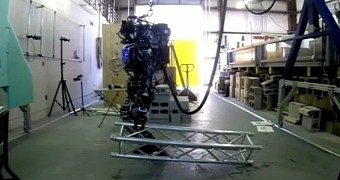Most robots may not be able to walk properly, and those that do have the ability might not be able to do much else. However, there are some that do have certain aptitudes, like the MIT Atlas you can watch in the video below.
There's a reason the name of Atlas is used for people and things that exhibit great strength. Athlas was originally the name of the primordial Titan who held up the celestial spheres in Greek mythology.
There are many portrayals of him in mythos, as well as popular media, but the bottom line is that he's very physically strong.
Add to that the awesomeness of Greek names in general and it's easy to see why MIT named a certain robot “Atlas.”
The Atlas of the modern age
A vaguely humanoid semi-automaton, the robot was created several years ago by a group of researchers, who have spent the past year merely improving it every way they could.
As you might expect, improving its ability to lift heavy objects figured high on their list, as did the ability to use that physical strength properly. They have been preparing for DARPA's Robotics Challenge, you see.
The results of their ministrations are plain to see in the video below. The Atlas can drag around a nice, large metal pillar like it's nothing. Sure, aluminum isn't nearly as heavy as, say, steel, but the team had to take into account the weight of the bot itself and the likelihood of it tipping over if the pillar was too heavy.
Future prospects
Perhaps in the future the MIT scientists will figure out how to enable the Atlas to properly lift the object, maybe get it as high as overhead.
Right now, though, it's not exactly easy, because the robot either lacks the software or the sensors needed to automatically compensate for the loss of balance. It wouldn't be a great showing at DARPA's Robotic Challenge if Atlas falls on its face after all (or what passes for a face anyhow).
It has its own weight to throw against the extra load, but it might not have the flexibility needed, or the hardware-software ability to lean/jolt to the opposite side of whatever it's trying to pick up.
Even if it doesn't manage to lift things all the way up, however, the Atlas already has great potential for use in construction, debris clearing after disasters, even search-and-rescue, although that last bit might be dependent on the improvement in its walking speed. Trudging isn't exactly conductive to quick interventions.

 14 DAY TRIAL //
14 DAY TRIAL // 